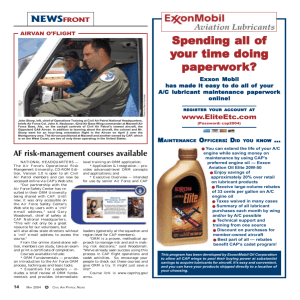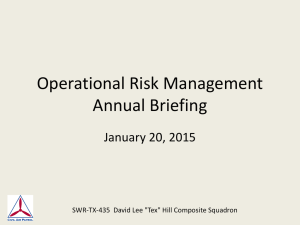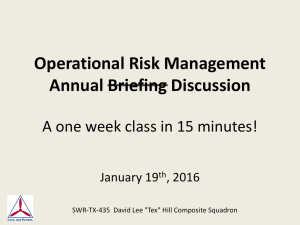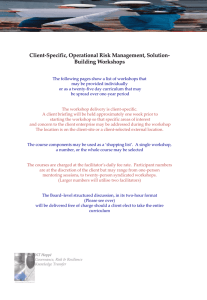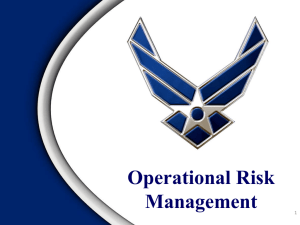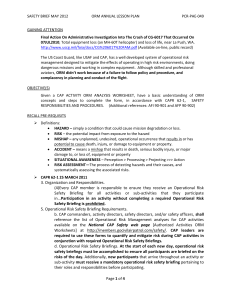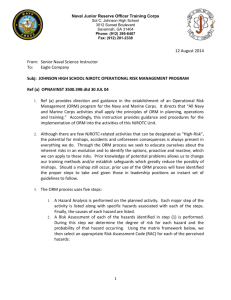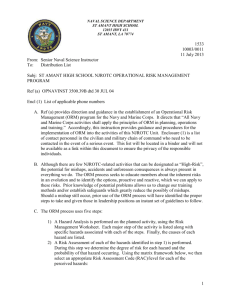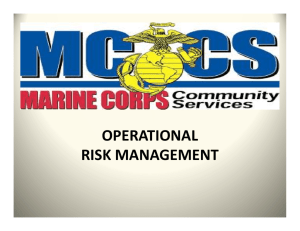CAP National Safety Down Day - Southwest Region, Civil Air Patrol
advertisement
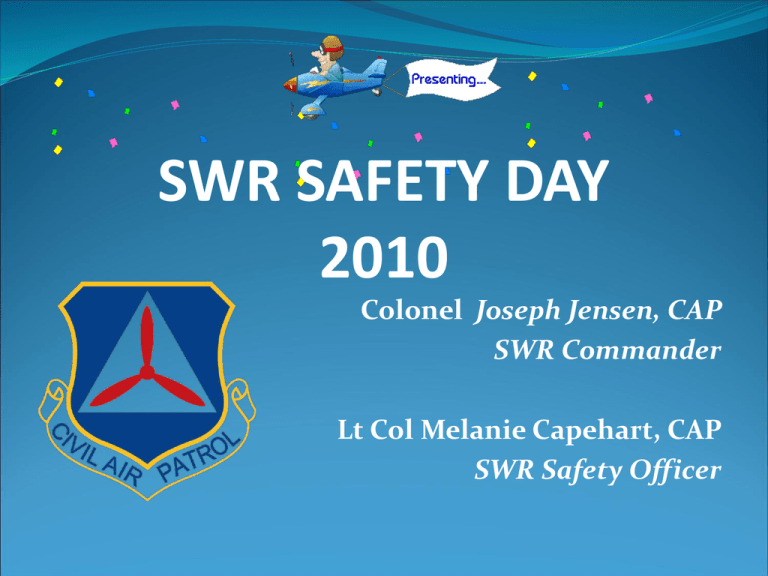
SWR SAFETY DAY 2010 Colonel Joseph Jensen, CAP SWR Commander Lt Col Melanie Capehart, CAP SWR Safety Officer SAFETY PLEDGE As a Civil Air Patrol member I pledge to promote an uncompromising safety environment for myself and others, and to prevent the loss of, or damage to Civil Air Patrol assets entrusted to me. I will perform all my activities in a professional and safe manner, and will hold myself accountable for my actions in all of our Missions for America. SAFETY DAY • Safety Days are designed to assemble our personnel to discuss and increase awareness of safety related issues. Civil Air Patrol borrows this tradition from the USAF. STOP - step back from the high pace and intensity of our day-to-day operations • Think about exactly how we're doing our business -- what are the risks out there and what can we do to get rid of them. WHY A SAFETY DAY Pause for introspection Look at unit culture – how the unit trains, talks, acts and listens Look at your self – your attitude toward risk Focus on problem areas (trends) This is a pre-emptive strike on future mishaps To help keep us safe on and off-duty WHY A SAFETY DAY Directed by the CAP National Commander -help us start the new fiscal year in the right direction Per CAPR 62-2 An annual Safety Day will be held in all units sometime during the month of October to focus on improving safety knowledge and attitudes during the new fiscal year. -Significant overall increase in mishaps. -Up coming changes to CAP REG 62-1 -Safety Survey (Complete on eServices beteen 1 October and 31 January each fiscal year). TOPICS There are a wide variety of topics and events you can use in your safety day. An entire safety day can be dedicated to a certain theme, depending on upcoming operations. For today, however, we will cover: Operational Risk Management (ORM) Specifically cadet activities Van Safety Soft/Short Field Landing Safety Culture LINKS Use these quick and easy summaries to find out about something new you're doing or as a refresher for something you haven't done in a while. They're a great training tool to pass around at meetings, through e-mail, or post on bulletin boards. •http://www.safetycenter.navy.mil/safetips/default.htm •http://www.nsc.org/library/facts.htm •http://www.cpsc.gov/tips.html Operational Risk Management (ORM) Fundamentals ORM •We hate to beat ORM into the ground but it is just not being used effectively… ORM • Have you ever tried explaining ORM to someone outside of CAP and gotten that “deer in the headlights” look? •Have you ever tried to recite from memory the six steps to ORM just to find yourself fumbling with those two fleeting steps you just can’t quite put your finger on? •CAP leaders are encouraged to use the ORM forms to quantify and mitigate risk during CAP activities(F104, F73, F71, F99). ORM • Operational Risk Management is a decision-making process to systematically evaluate possible courses of action, identify risks and benefits, and determine the best course of action for any given situation • Whether you are evaluating the risks associated with using a new piece of equipment in the workplace or evaluating the risks of swimming in an unmarked area, you can use the same decision-making process to determine the best course of action. KEY PRINCIPLES • Four Key Principles • Accept no unnecessary risk. • Make risk decisions at the appropriate level. Accept risk when the benefits outweigh the costs. Integrate ORM into CAP doctrine and planning at all levels • • SIX-STEP PROCESS SIX-STEP PROCESS Step 1: Identify the Hazard A hazard is any real or potential condition that can cause mission degradation; injury, illness, or death to personnel; or damage or loss of equipment or property. Step 2: Assess the Risk Quantify and qualify the probability and severity of loss from exposure to the hazard. SIX-STEP PROCESS Step 3: Analyze Risk Control Measures Investigate a variety of actions which will either reduce or eliminate the risk. Step 4: Make Control Decisions The appropriate decision maker uses cost versus benefit analysis to choose the best control's. SIX-STEP PROCESS Step 5: Implement Risk Controls Plan for implementation of control's and the commitment of resources to do it. Step 6: Supervise and Review Proactive and personal follow-up on effectiveness of control's. LEVELS OF RISK MANAGEMENT •ORM is designed to help you in your decisionmaking process. •It's not intended to be a time-consuming effort. •Therefore, use only the amount of risk management necessary for the task. THREE LEVELS OF RISK levels 1: Time Critical Used when there is little time, little complexity, or low risk. Often used during the execution phase of an operation where an unplanned change occurs and must be managed. It's easily applied to off-duty situations. THREE LEVELS OF RISK levels 2: Deliberate •Used in the majority of workplace applications where experience in a group setting will produce the best results. THREE LEVELS OF RISK levels 3: Strategic Used in high priority or high visibility situations, strategic ORM generally requires use of more thorough hazard identification and risk assessment tools. Generally reserved for the more complex and riskier efforts, as it may be time consuming. CAPR 62-1 Safety Education and Accident Prevention Training Units should present a live safety meeting for its members each month. All CAP members must participate in monthly safety education briefing. The monthly requirement expires at the end of the month following its completion. Will me maintained in eServices. CAPR 62-1 Once Annually – ORM ALL Members get latest Safety Meeting Info before participating in any CAP activity Reports of topics and number attending SHALL be forwarded to next higher echelon of command Annual Safety Day each October Safety Officer SHALL complete the on line Basic Safety Course and test located on the National CAP website WITHIN 90 DAYS of appointment. Cadet Programs Safety and cadet activities Car sickness Leg Cramp Fell on stairs Cadets foot ran over by plane tire X2 Sprained Wrist/Ankle during PT Cut finger x2 Stung by Jellyfish Hit head kayaking Heat exhaustion/DEHYDRATION Van Safety VAN SAFETY • Damage by Trailer while backing • Scratches found unknown how occurred • Backed into planter BACKING UP TIPS Backing is the main culprit in CAP van damage •USE A Spotter •Back to the left (driver’s side) •Avoid backing up if you miss a ramp/exit. •Use outside mirrors. •Check for objects around vehicle before entering and before backing. Aircraft Safety Aircraft Safety •Hard landing – damaged becker •Backing in hanger – hit cabinet 2x •Bird strike – carb intake bent •Hard landing – rear tie down sheared off •Hard landing – Prop bent / becker damage •Air/fuel mix problems •Blown tire after landing •Engine failure Tow Hooks / Becker Tail Strike Video SAFETY CULTURE When you look in the mirror, you see the person most responsible for your safety Let’s Make FY 2010 a Banner Year for Safety + = SWR = CULTURE OF SAFETY THANK YOU FOR YOUR TIME
